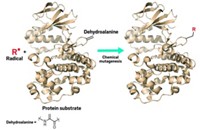Advertisement
Grab your lab coat. Let's get started
Welcome!
Welcome!
Create an account below to get 6 C&EN articles per month, receive newsletters and more - all free.
It seems this is your first time logging in online. Please enter the following information to continue.
As an ACS member you automatically get access to this site. All we need is few more details to create your reading experience.
Not you? Sign in with a different account.
Not you? Sign in with a different account.
ERROR 1
ERROR 1
ERROR 2
ERROR 2
ERROR 2
ERROR 2
ERROR 2
Password and Confirm password must match.
If you have an ACS member number, please enter it here so we can link this account to your membership. (optional)
ERROR 2
ACS values your privacy. By submitting your information, you are gaining access to C&EN and subscribing to our weekly newsletter. We use the information you provide to make your reading experience better, and we will never sell your data to third party members.
Synthesis
Determining Sugar Sequence Fidelity
Substrate analogs probe how carbohydrate polymerases install monosaccharides in correct order
by Celia Henry Arnaud
April 30, 2012
| A version of this story appeared in
Volume 90, Issue 18

Unlike their nucleic acid and protein siblings, carbohydrate biopolymers have no templates to guide their synthesis. The polymerase enzymes that stitch them together ensure that they end up with the desired sequence of sugars and linkages.
But little is known about the faithfulness of carbohydrate polymerases. DNA polymerases have varying degrees of fidelity; however, researchers don’t know whether the same is true for carbohydrate polymerases. New work on one such polymerase, galactofuranosyltransferase 2 (GlfT2), suggests that it is. The findings may point to a general strategy for determining what controls the fidelity of the enzymes responsible for building critical cellular carbohydrates.
GlfT2 catalyzes the synthesis of galactan in the cell wall of Mycobacterium tuberculosis. The enzyme uses uridine diphosphate (UDP) galactofuranose as a donor substrate to add 30 to 35 galactofuranose residues with alternating β-(1→5) and β-(1→6) linkages to the growing galactan chain.
Researchers are trying to figure out how specific GlfT2 actually is. Independent groups led by Todd L. Lowary of the University of Alberta and Laura L. Kiessling of the University of Wisconsin, Madison, have developed substrate analogs to probe how GlfT2 works.
Previous work from both the Lowary and Kiessling groups suggests that despite catalyzing two reactions—creation of not only β-(1→5) but also β-(1→6) linkages—GlfT2 has only one active site (ChemBioChem, DOI: 10.1002/cbic.200900202; Biochemistry, DOI: 10.1021/bi201820p).
Kiessling and Lowary now report several sugar analogs that probe how changes to the donor sugar affect that active site’s specificity. Kiessling’s group used fluorinated analogs (J. Am. Chem. Soc., DOI: 10.1021/ja301723p), whereas Lowary’s group made a series of methylated and deoxygenated versions (Org. Biomol. Chem., DOI: 10.1039/c2ob25159k).
Lowary says the various analogs allow them to study different characteristics of the active site. Fluorine and deoxygenation both probe hydrogen-bonding interactions, whereas methylation reveals steric requirements. In both the fluoro and deoxy analogs, if the modification is at the C-5 position, the next sugar adds to the C-6 position, and vice versa. Because the enzyme prefers to create sugar chains with alternating linkages, the substitution blocks the next glycosylation site and abruptly terminates polymer elongation.
Kiessling chose fluorine analogs because their electronegativity is similar to that of the hydroxyl groups they replaced. Therefore they disrupt neither the overall conformation nor the pKa of the adjacent hydroxyl, she says.
With the right combination of starting substrate and fluorosugar, Kiessling was able to push the enzyme to add a second fluorosugar—as long as the linkages still alternated correctly. But the enzyme quit after the second sugar. Therefore, the enzyme can handle a fluorinated substrate but terminates elongation in response to an impending incorrect linkage.
With methylated or deoxygenated analogs, the enzyme never added more than one sugar. The deoxygenated sugar eliminates key hydrogen bonds between the donor and the enzyme, Lowary says.
The fluoro and deoxy results are both consistent with such a hydrogen bond, Lowary points out. “With the deoxy analog, there’s no possibility for hydrogen bonding. In the fluoro case, there’s some potential for H to F hydrogen bonding. If you take the two pieces of data, they suggest there’s an essential hydrogen bond involving the hydroxyl group next to the site of reaction,” he says.
Such an approach could be generally applicable to studying other carbohydrate polymerases, Kiessling says. She’s particularly keen to use such fluorinated sugars to study the fidelity of polymerases that make carbohydrates like heparan sulfate or chondroitin sulfate.
Rob Field, a carbohydrate chemist at the John Innes Centre, in Norwich, England, finds Kiessling’s fluorosugars intriguing. In addition to being used as structural probes, such fluorine-containing glycopolymers “can reasonably be expected to have interesting physical properties,” he says.
“The Kiessling work draws parallels between chain-terminating sugars for dissecting biosynthetic processes and Sanger sequencing of nucleic acids—a methodology that provided a step-change in molecular biology,” Field says. “Only time will tell if chain-terminating sugar nucleotides have the potential to be similarly transformative for glycobiology.”




Join the conversation
Contact the reporter
Submit a Letter to the Editor for publication
Engage with us on Twitter